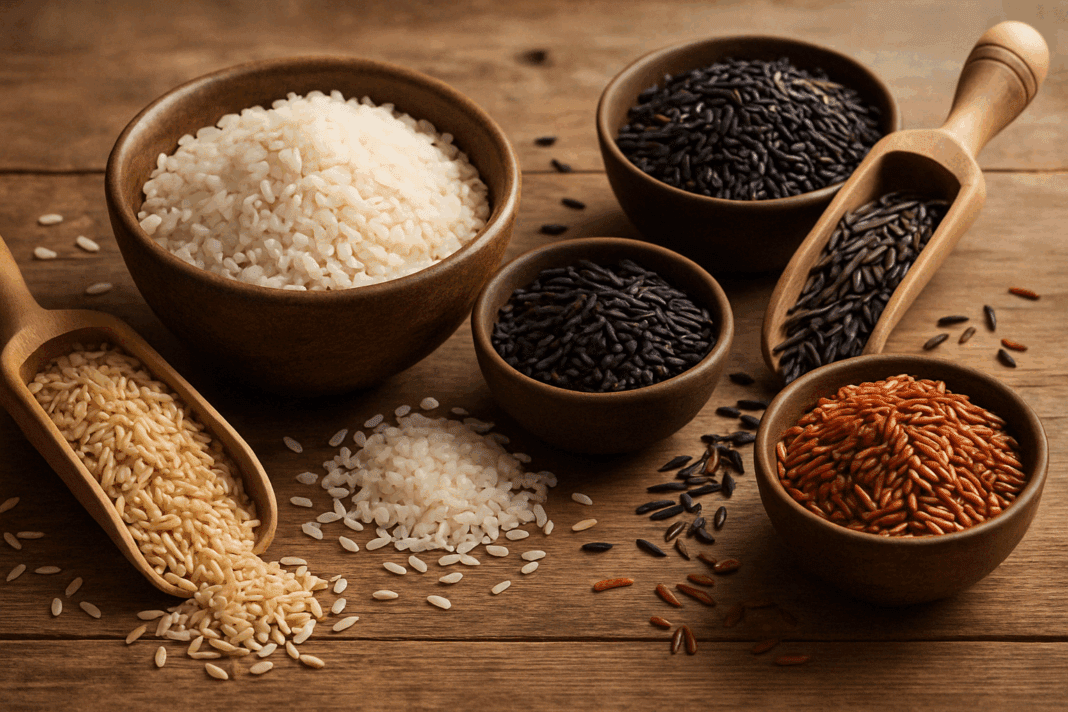Rice has long been a dietary staple across continents, cultures, and generations. Its ability to nourish billions of people around the world, whether in the form of aromatic basmati, sticky sushi rice, or hearty brown rice bowls, reflects its unparalleled culinary versatility. But as nutrition awareness grows and more people aim to clean up their diets through whole-food eating, a critical question arises: is rice a whole food, and if so, does that include white rice?
This question is more than semantic. It touches on core principles of mindful eating, nutrient density, and the science of food processing. For those transitioning to a healthier lifestyle or following a whole-food, plant-based diet, understanding whether rice qualifies as a whole food has both practical and nutritional implications. This article unpacks what it means for a food to be “whole,” explores the differences between brown and white rice, and reveals what nutrition science and health experts have to say about rice’s role in a balanced diet.
You may also like: How a Whole Foods Diet Supports Sustainable Weight Loss: Expert Tips for Eating Whole Foods to Lose Weight Safely
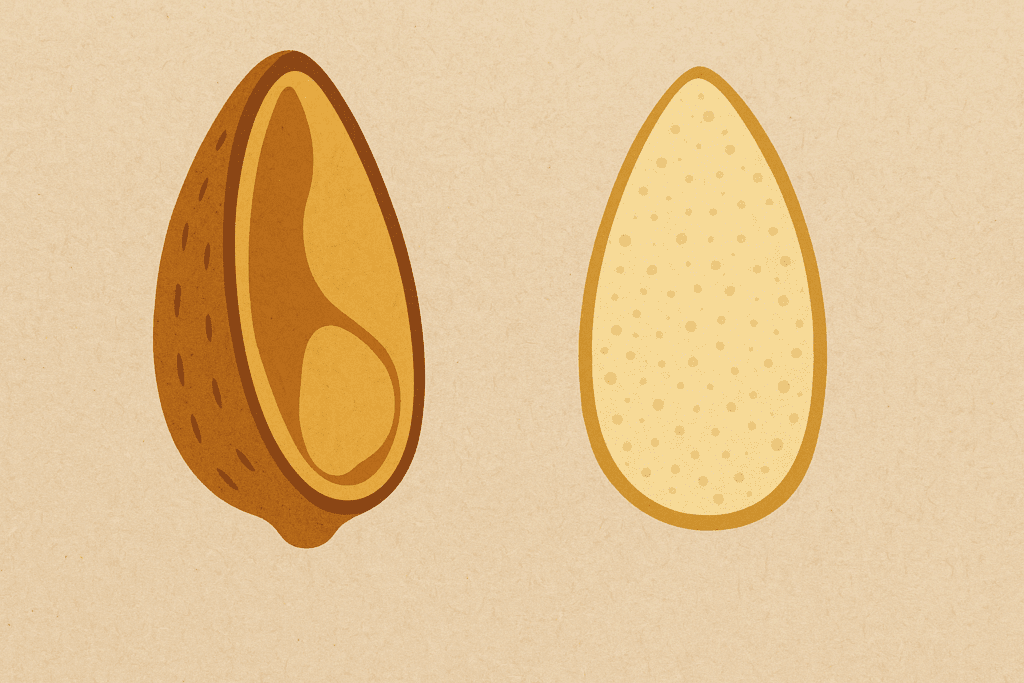
What Defines a Whole Food? Understanding the Basics
The term “whole food” refers to foods that are minimally processed and retain their natural, original components. In nutritional science, a food is considered whole when it includes all parts of its original structure. For grains, this means the bran, germ, and endosperm must remain intact. The bran provides fiber and antioxidants, the germ offers essential fatty acids and vitamins, and the endosperm contains carbohydrates and protein.
Whole foods stand in contrast to refined or processed foods, which undergo mechanical and chemical changes that strip away nutrients, fiber, and beneficial plant compounds. Processing often improves shelf life and texture but at the cost of nutritional value. When we ask, is rice a whole food, we’re really asking if it maintains its full grain structure—or if it’s been refined in a way that compromises its health benefits.
This distinction is important in guiding food choices. Whole foods are associated with better metabolic health, reduced inflammation, and lower risk of chronic diseases. As more people seek out foods that support longevity, gut health, and sustainable energy, defining what truly counts as a whole food becomes an essential step in dietary education.
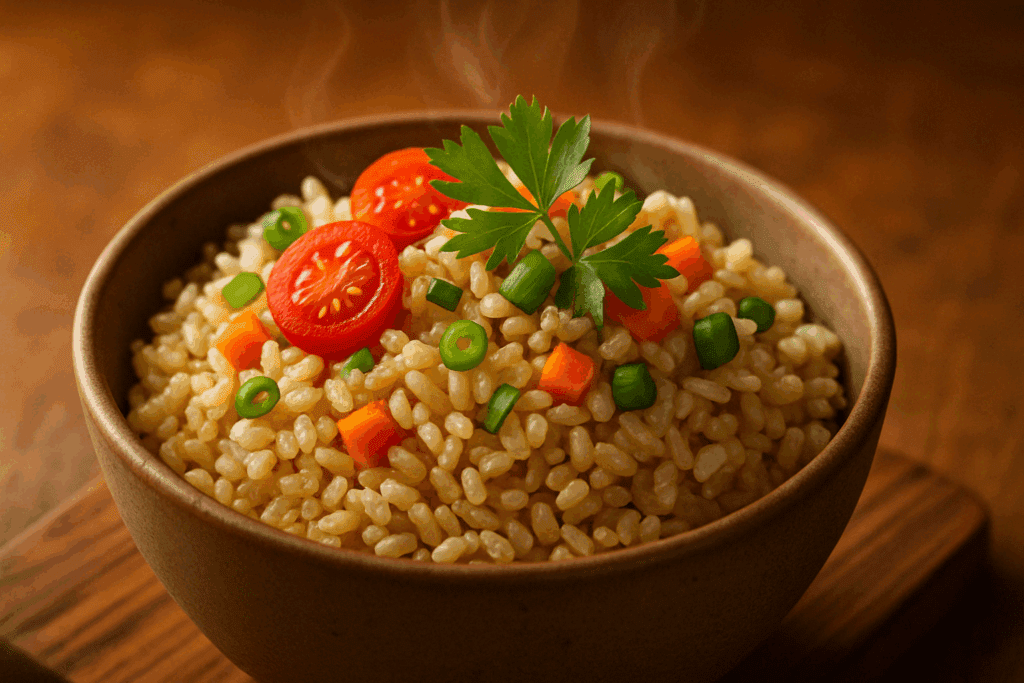
Is Brown Rice a Whole Food? The Nutritional Powerhouse of Whole Grains
Brown rice meets the definition of a whole food because it includes the bran, germ, and endosperm. It undergoes minimal processing—typically only the outer husk is removed, leaving the grain structurally and nutritionally intact. As such, brown rice offers a rich source of dietary fiber, B-complex vitamins, iron, magnesium, selenium, and plant-based compounds like lignans and flavonoids.
One of brown rice’s standout health benefits is its high fiber content, which plays a key role in digestive regularity, blood sugar regulation, and cholesterol balance. This fiber also helps promote satiety, which can support healthy weight management. In fact, many people transitioning to a more mindful eating approach choose brown rice for its ability to keep them full longer and its slow, steady release of energy.
So, is rice considered a whole food when it’s brown? Absolutely. Brown rice is a textbook example of a whole grain and is widely endorsed by organizations like the American Heart Association and Harvard’s School of Public Health as part of a heart-healthy, nutrient-rich diet.
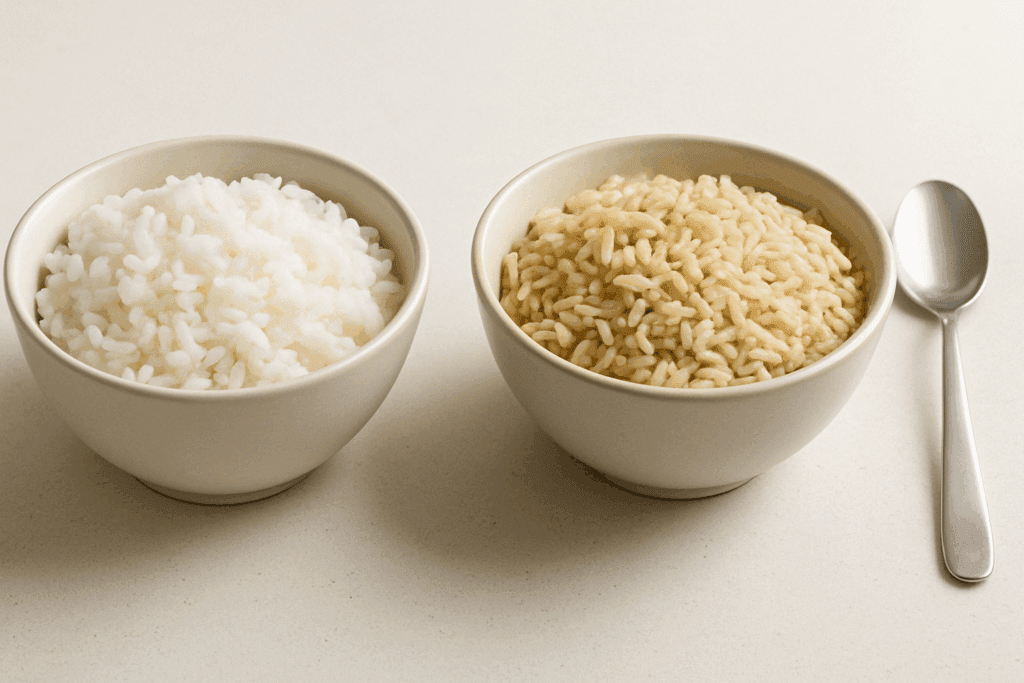
Is White Rice a Whole Food? Unpacking the Refinement Process
White rice, unlike its brown counterpart, has been refined. The processing removes the bran and germ, leaving only the starchy endosperm behind. While this makes white rice easier to chew and quicker to cook, it significantly diminishes its nutritional profile. It contains less fiber, fewer vitamins, and minimal antioxidants.
Because of this, white rice does not qualify as a whole food under current nutritional definitions. When considering rice a whole food, the answer is no when referring to white rice. Although some white rice is enriched with added nutrients, such enrichment cannot fully replace the diverse and synergistic components lost during milling.
That said, white rice still has a place in cultural and culinary traditions. It pairs well with legumes and vegetables and can serve as a digestible carbohydrate source, particularly for those recovering from illness or dealing with gastrointestinal sensitivities. However, in the context of mindful eating and optimal health, white rice should be viewed as an occasional staple rather than a core whole-food option.
Rice Within a Whole-Food, Plant-Based Lifestyle
A whole-food, plant-based (WFPB) diet prioritizes foods in their most natural, unprocessed state. In this context, brown rice is a perfect fit. It provides complex carbohydrates, plant-based protein, and essential nutrients that support long-term wellness.
Whole rice varieties like black, red, and wild rice also fall into this category. These pigmented varieties are particularly rich in antioxidants such as anthocyanins and flavones, which have anti-inflammatory properties and may reduce oxidative stress. Including a variety of whole rice types can offer both nutritional diversity and culinary excitement, making healthy eating more sustainable and enjoyable.
When people ask, is rice considered a whole food, the form matters. Brown and wild rice align beautifully with the goals of a plant-based lifestyle, whereas white rice does not support those goals as effectively due to its refined nature. Choosing whole grain rice can help individuals build a plate that is satisfying, culturally respectful, and aligned with evidence-based nutrition.
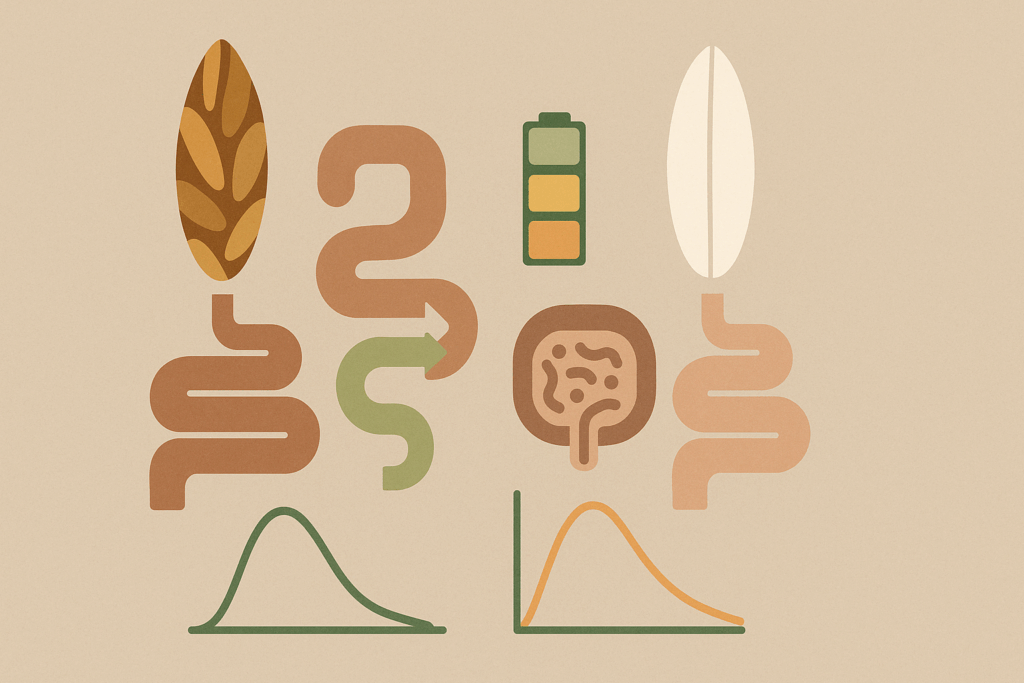
Scientific Insights: Comparing Brown Rice and White Rice
Brown rice and white rice may come from the same grain, but their nutritional differences are substantial. Brown rice has nearly three times the fiber of white rice and retains important micronutrients like magnesium, phosphorus, and selenium. It also offers a small but meaningful amount of healthy fats from the germ layer.
Another critical difference lies in their effect on blood sugar. Brown rice has a lower glycemic index than white rice, meaning it causes a slower rise in blood glucose. This can benefit people with diabetes or those trying to maintain steady energy levels. For people with metabolic concerns, the slower digestion and absorption of brown rice can be especially beneficial.
From a weight management perspective, brown rice also provides a better sense of fullness. The fiber and nutrient density make it more satiating, which can help prevent overeating. When debating is rice a whole food, brown rice clearly delivers in both form and function, while white rice offers convenience at the expense of nutritional richness.
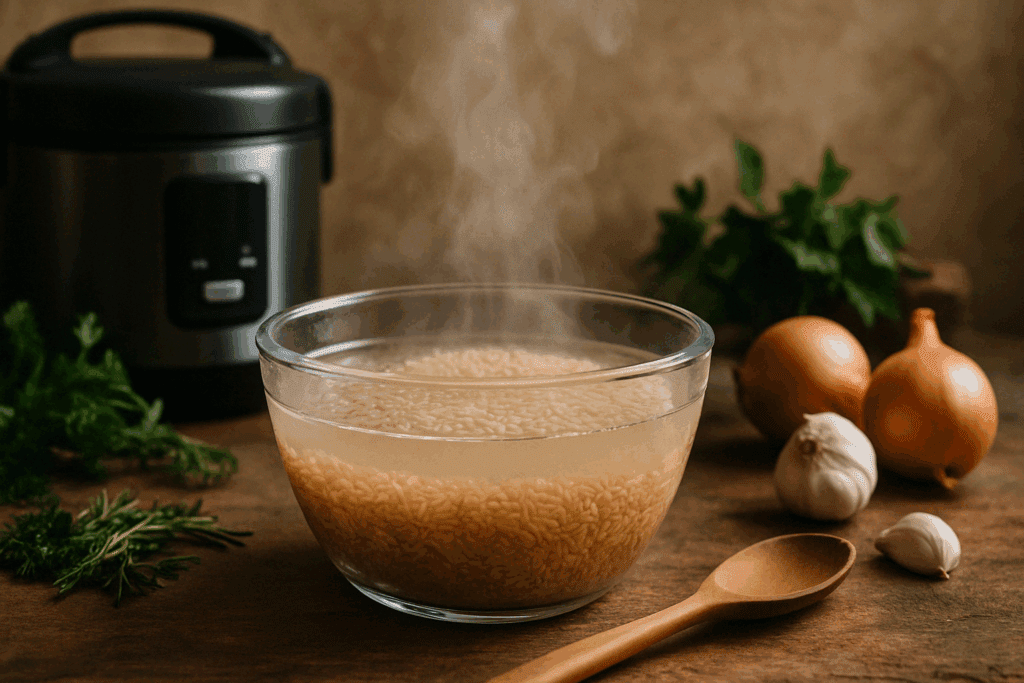
Cooking with Whole Rice: Tips for Better Flavor and Digestibility
If you’re new to brown or wild rice, the transition can take some getting used to. Brown rice has a slightly nutty flavor and firmer texture, which some people initially find less appealing than fluffy white rice. But there are easy ways to bridge the gap.
Soaking brown rice before cooking—preferably overnight—can soften the texture and reduce cooking time. It also helps break down phytic acid, a natural compound that may inhibit mineral absorption. Using a pressure cooker or a rice cooker with a “brown rice” setting can also ensure consistent results and a more tender bite.
You can also blend brown and white rice together in a 50/50 ratio as a transitional approach. Over time, gradually increasing the proportion of brown rice can help retrain your palate while still keeping meals familiar.
Adding herbs, spices, vegetable broth, or aromatic vegetables like garlic and onions to the cooking water can further enhance the taste and make the switch to whole rice more enjoyable. This simple strategy aligns with a broader philosophy of mindful eating: finding ways to make healthy choices appealing, accessible, and sustainable.

Health Outcomes Tied to Whole Grain Consumption
Scientific literature overwhelmingly supports the health benefits of whole grain consumption. Numerous cohort studies and randomized controlled trials have found that diets rich in whole grains, including brown rice, are associated with a reduced risk of heart disease, type 2 diabetes, obesity, and certain types of cancer.
A landmark meta-analysis published in The Lancet concluded that individuals who consumed the highest amounts of whole grains had a 19% lower risk of coronary heart disease and a 22% lower risk of total mortality compared to those with the lowest intake. These protective effects are attributed to the fiber, antioxidants, vitamins, and phytochemicals found in whole grains—nutrients that are largely absent in refined grains like white rice.
When health-conscious consumers ask, is rice a whole food, they are often trying to determine whether eating it will align with longevity and disease prevention goals. The answer depends on the type of rice. Whole grain rice not only fits within the whole food category but also contributes to improved health outcomes supported by decades of nutritional science.
Making Informed Choices for Everyday Eating
Choosing rice that aligns with your health goals doesn’t mean abandoning tradition or flavor. Brown rice, black rice, and other whole grain options can be prepared in delicious ways that enhance both taste and nutrition. They work beautifully in curries, stir-fries, grain bowls, and even breakfast dishes like rice pudding with almond milk and berries.
For those looking to build a more nutrient-dense pantry, consider purchasing rice in its whole form, buying organic when possible, and cooking in larger batches to save time throughout the week. Keep cooked rice refrigerated and reheat with a splash of water or broth to maintain moisture.
Most importantly, remember that mindful eating is about more than individual ingredients. It’s about patterns and habits. While white rice can still have a place on your plate occasionally, regularly choosing whole rice varieties helps anchor your meals in fiber-rich, minimally processed, nourishing foods that support well-being over the long haul.
Frequently Asked Questions: Understanding Rice as a Whole Food in a Modern Diet
1. Can rice be part of an elimination diet or anti-inflammatory protocol?
Yes, rice—particularly whole varieties like brown, red, or black rice—can be included in elimination diets and anti-inflammatory meal plans. Since these types of rice are naturally gluten-free and minimally allergenic, they’re often used as safe, neutral carbohydrates during gut-healing protocols. However, it’s important to note that not all rice is created equal. When someone asks is rice a whole food in the context of elimination diets, the answer hinges on whether the rice has retained its natural fiber and nutrient layers. Because white rice is stripped of key components during processing, it doesn’t offer the same anti-inflammatory support and typically wouldn’t be considered a whole food for such specialized therapeutic purposes.
2. Are there any environmental or sustainability differences between whole and refined rice?
Yes, there are notable environmental distinctions, especially when considering milling, water use, and energy input. Producing brown rice uses less energy overall because it involves fewer processing steps compared to white rice. That said, brown rice can spoil more quickly due to its oil-rich germ, which may lead to more food waste if not stored properly. From a sustainability standpoint, choosing locally grown, organic whole rice supports more environmentally conscious agriculture. So, when evaluating is rice considered a whole food from an eco-health perspective, brown and wild rice varieties not only retain their nutritional integrity but also tend to align more closely with regenerative farming principles.
3. How does whole rice affect mental clarity and cognitive function?
Whole grains like brown rice may support cognitive health due to their steady glucose release and micronutrient profile. Unlike refined grains, which can cause rapid blood sugar spikes and crashes, whole rice provides a more consistent source of energy to the brain. This helps maintain focus, reduce brain fog, and support neurotransmitter synthesis. B vitamins found in whole rice, such as thiamin and niacin, are crucial for brain health and mood regulation. So, while someone may wonder is rice a whole food in terms of physical wellness, the cognitive and psychological benefits of whole rice further support its role in a brain-boosting diet.
4. Can whole rice help support hormone balance or endocrine health?
Emerging research suggests that whole grains, including whole rice, may play a role in modulating hormones like insulin, cortisol, and estrogen. Brown rice contains lignans and phytonutrients that may influence estrogen metabolism and reduce the risk of hormone-related cancers. Additionally, its high fiber content helps regulate insulin response and may lower circulating cortisol levels by stabilizing blood glucose. These benefits are often diminished or absent in refined rice, which lacks the necessary plant compounds and fiber. From this lens, answering is rice a whole food becomes crucial for those seeking dietary strategies to support hormone health, particularly during perimenopause, metabolic syndrome, or adrenal fatigue.
5. Does eating whole rice impact your microbiome differently than eating white rice?
Yes, dramatically so. Whole rice feeds beneficial gut bacteria due to its resistant starch and fiber content, contributing to microbial diversity and short-chain fatty acid production. This supports a healthier gut lining, better immune response, and reduced systemic inflammation. In contrast, white rice is rapidly absorbed in the upper intestine and provides little substrate for the gut microbiota, offering minimal support to the microbiome. For those aiming to optimize gut health, the question is rice considered a whole food, becomes more than a classification—it becomes a matter of how your digestive ecosystem is being fed or starved.
6. Are there traditional cultures where brown rice has always been used instead of white?
Interestingly, while white rice dominates in many parts of Asia today, several cultures historically relied on minimally processed whole rice, particularly in rural or mountainous areas. In regions of Bhutan, red and black rice have been cultivated and consumed for generations, prized for their texture and ceremonial significance. Similarly, in parts of South India and Sri Lanka, hand-pounded or partially polished rice was traditionally used and still remains part of Ayurvedic practice. The question is rice a whole food is culturally nuanced, as industrialized milling only became widespread in the last century, meaning many ancestral diets were rich in whole rice varieties.
7. How does soaking or sprouting rice affect whether it qualifies as a whole food?
Soaking or sprouting brown rice does not remove any part of the grain; in fact, it enhances its whole food benefits by reducing antinutrients like phytic acid and improving bioavailability of minerals. Sprouting also activates enzymes and boosts levels of certain antioxidants and amino acids, such as gamma-aminobutyric acid (GABA), which is known for its calming effects. These methods actually make the rice more digestible while maintaining its full structure. So when wondering is rice a whole food in its sprouted form, the answer is yes—and it might even be more beneficial than its unsprouted version for some people.
8. Is rice considered a whole food when used in processed or packaged snacks?
Not necessarily. Even if brown rice is used as an ingredient, once it’s puffed, extruded, or combined with oils and sugars, it often loses its whole-food status. These processing techniques can degrade fiber structure and alter glycemic response. Brown rice chips or puffed rice snacks may sound healthier than refined options, but they often fall short in delivering the metabolic and digestive benefits of intact, cooked whole rice. In these cases, asking if rice is considered a whole food helps consumers distinguish between clever marketing and genuine nutrition. True whole food eating involves minimal processing, not just whole ingredients used in refined formats.
9. How does rice fit into longevity-focused diets like the Blue Zones or Okinawan model?
In many longevity-focused diets, including those observed in Blue Zones like Okinawa, rice is consumed in its whole or semi-polished form, often paired with legumes, sea vegetables, and fermented foods. The rice eaten is typically served in moderate portions and rarely consumed in isolation. These meals exemplify dietary synergy—how whole rice works in tandem with other nutrient-dense ingredients to lower inflammation and improve metabolic health. When viewed through this lens, is rice a whole food becomes a question not just of processing, but also of context. Whole rice supports longevity best when it’s part of a fiber-rich, diverse, and plant-forward eating pattern.
10. What future innovations are emerging in whole rice cultivation and nutrition?
Innovations in rice farming are leading to the development of biofortified rice varieties that are both whole and nutritionally enhanced. Golden rice, for instance, was engineered to provide more vitamin A precursors, though its widespread adoption remains debated. Other developments include heirloom rice preservation, carbon-conscious rice paddies, and regenerative agriculture techniques that promote biodiversity and reduce methane emissions. In urban wellness circles, there’s growing interest in ancient whole rice strains like Kodo, Job’s Tears, and Himalayan black rice for their unique phytochemical profiles. As public interest grows in rice considered a whole food, we can expect both scientific and culinary innovation to shape the future of whole grain eating.
Conclusion: Understanding Whether Rice Is a Whole Food—and Why It Matters for a Healthier Life
So, is rice a whole food? The answer depends on which kind you’re eating. Brown rice, wild rice, black rice, and red rice are all considered whole foods because they retain the original components of the grain—the bran, germ, and endosperm. These whole rice varieties align with the principles of mindful eating and plant-based nutrition, offering a wealth of fiber, vitamins, minerals, and phytochemicals that support digestion, heart health, and long-term vitality.
On the other hand, white rice has been stripped of these beneficial components and is therefore not considered a whole food. While it can still be enjoyed in moderation and within cultural or comfort-based meals, it lacks the nutritional density that defines whole grains.
For anyone pursuing a healthier lifestyle, the choice between brown and white rice is more than a culinary preference—it’s a nutritional strategy. Prioritizing whole rice supports a diverse gut microbiome, better metabolic regulation, and overall improved health outcomes. When asking if rice is considered a whole food, the answer becomes a roadmap for smarter, more nourishing eating—rooted in science, informed by tradition, and guided by intention.
Was this article helpful? Don’t let it stop with you. Share it right now with someone who needs to see it—whether it’s a friend, a colleague, or your whole network. And if staying ahead on this topic matters to you, subscribe to this publication for the most up-to-date information. You’ll get the latest insights delivered straight to you—no searching, no missing out.
Further Reading:
Brown Vs. White Rice —Is One Better for Your Health?
Brown rice versus white rice: A head-to-head comparison
Disclaimer
The information contained in this article is provided for general informational purposes only and is not intended to serve as medical, legal, or professional advice. While NewsHealthWatch strives to present accurate, up-to-date, and reliable content, no warranty or guarantee, expressed or implied, is made regarding the completeness, accuracy, or adequacy of the information provided. Readers are strongly advised to seek the guidance of a qualified healthcare provider or other relevant professionals before acting on any information contained in this article. NewsHealthWatch, its authors, editors, and contributors expressly disclaim any liability for any damages, losses, or consequences arising directly or indirectly from the use, interpretation, or reliance on any information presented herein. The views and opinions expressed in this article are those of the author(s) and do not necessarily reflect the official policies or positions of NewsHealthWatch.

